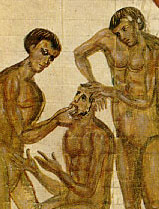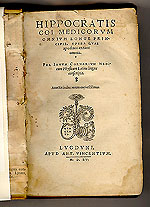Manuscript Illustration, 14th Century





Manuscript Illustration, 14th Century 
MS C. 54, Zentralbibliothek Zurich, The Four Humors. The ancient doctrine of the Four Humors, as illustrated in this medieval manuscript was to tie them to four basic temperaments (above, clockwise): phlegmatic, sanguine melancholic and choleric. |
THE HUMORAL THEORYThe elaborate general doctrine of the Four Humors endured through many centuries and is central to the tenets of the Hippocratic Corpus. It was grounded on the Empedoclean principle of the four supposed elements: earth, air, fire and water. The four constituent elements, or humors, in man were identified analogously as phlegm, blood, yellow bile and black bile, all of which had to be in correct proportion to one another. The fourfold pattern was infinitely adaptable: to the seasons, the winds, the elements, and even, in due course, to the Evangelists. It offered a kind of universal holdall, in which tastes, temperaments, and a surprising number of diseases could find loose accommodation. Though virtually worthless as a theory, it remained the fundamental prop of European medicine for over two millennia. |
GREEK ORTHOPAEDICSOrthopaedics originally was the branch of ancient Greek surgery that concerned itself with reducing or realigning bodily distortions. It is thought that it was strongly influenced by the techniques of treating athletes in the gymnasia. So far as written sources are concerned, the basic information comes indirectly from three Hippocratic treatises: Joints, Fractures and Surgery. These works are not extant but their contents were transmitted to the Western world by way of Greek manuscripts compiled by Apollonius in the first century BCE and by Soranus in the second century CE. Of all the subjects covered in the Hippocratic corpus, those volumes treating dislocations and fractures demonstrate the most affinity to modern technique and practice.
|
Manuscript from Byzantium, ca. 1100
Florence Laurentian Library, MS 74.7, Apollonius Dislocations 2 in Greek Bone setting of jaw The doctor seizes the jaw between his fingers and puts it in place while an assistant holds the patient's head. |
Frontispiece, 1555 edition of Hippocratis Coi Medicorum Omnium Longe Principis
|
THE HIPPOCRATIC CORPUSThe Hippocratic Corpus is a library, or rather, the remains of a library. Although the thirty four books which are included in the Collection were attributed to Hippocrates himself in antiquity, scholars now know that they were in all likelihood composed between the sixth and fourth centuries BCE. Between the career of Hippocrates and the pre-Socratic philosophers a special kind of prose for medical writings was developed in Greece. Although the island home Cos of Hippocrates is located within what was a Doric speaking region, the medical writers of Cos who developed the Hippocratic treatises appropriated the dialect of philosophy, that is Ionic. The use of Ionic instead of the native Doric dialect is analogous to the practice of Renaissance scientists, such as Andreas Vesalius, using Latin instead of the vernacular for their treatises. |